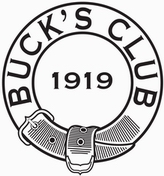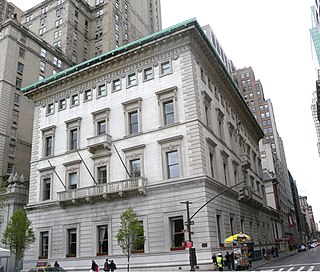Related Research Articles

Fleet Street is a street in Central London, England. It runs west to east from Temple Bar at the boundary of the Cities of London and Westminster to Ludgate Circus at the site of the London Wall and the River Fleet from which the street was named.
The Savage Club, founded in 1857, is a gentlemen's club in London, named after the poet, Richard Savage. Members are drawn from the fields of art, drama, law, literature, music or science.

Ye Olde Cheshire Cheese is a Grade II listed public house at 145 Fleet Street, on Wine Office Court, City of London. Rebuilt shortly after the Great Fire of 1666, the pub is known for its literary associations, with its regular patrons having included Charles Dickens, G. K. Chesterton and Mark Twain.

White's is a gentlemen's club in St James's, London. Founded in 1693 as a hot chocolate shop in Mayfair, it is the oldest gentleman's club in London. It moved to its current premises on St James's Street in 1778.

The Savile Club is a traditional gentlemen's club in London that was founded in 1868. Located in fashionable and historically significant Mayfair, its membership, past and present, includes many prominent names.

The Naval and Military Club, known informally as The In & Out, is a private members' club located in St James's Square, London. It was founded in 1862 for officers of the Navy and Army. It now also accepts female members, and members who have not served in the armed forces, but continues to observe service traditions.

Buck's Club is a gentlemen's club in London, located at 18 Clifford Street, established in June 1919. P. G. Wodehouse mentions it in some stories and modelled his Drones Club mostly after Buck's. It is probably best known for the Buck's Fizz cocktail, created there in 1921 by its bartender McGarry.

The Oxford and Cambridge Club is a traditional London club. Membership is largely restricted to those who are members of the universities of Oxford and Cambridge, including men and women who have a degree from or who are current students of either university.

St Stephen's Club was a private member's club in Westminster, London, founded in 1870.

Boodle's is a gentlemen's club in London, England, with its clubhouse located at 28 St James's Street. It was founded in January 1762 by Lord Shelburne, who later became Prime Minister of the United Kingdom and then 1st Marquess of Lansdowne.

Pratt's is a gentlemen's club in London, England. It was established in 1857, with premises in a house in Park Place, off St James's Street, and close to the Ritz.

The St James's Club was a London gentlemen's club which operated between 1857 and 1978. It was founded by two leading diplomats and its members continued to be largely diplomats and authors. It was first established in Bennet Street, and after a brief spell in Mayfair, moved to 106 Piccadilly by 1868. In the final quarter of the twentieth century many gentlemen’s clubs of London suffered from declining membership, and in 1978 the St James's Club merged with Brooks's Club and vacated its premises.

The Metropolitan Club is a private social club on the Upper East Side of Manhattan in New York City. It was originally founded as a gentlemen's club in 1891. The current building at Fifth Avenue and 60th Street was designed by McKim, Mead & White and completed in 1893.

The Conservative Club was a London gentlemen's club, now dissolved, which was established in 1840. In 1950 it merged with the Bath Club, and was disbanded in 1981. From 1845 until 1959, the club occupied a building at 74 St James's Street.

The City of London Club was established in 1832 and is the oldest of the gentlemen's clubs based in the City of London. Its Italian Palladian-style building was designed by English architect Philip Hardwick. Prince Philip, Duke of Edinburgh, was its royal patron.

Crockford's, the popular name for William Crockford's St James's Club was a London gentlemen's club, now dissolved. It was established in 1823, closed in 1845, re-founded in 1928 and closed in 1970. One of London's older clubs, it was centred on gambling and maintained a somewhat raffish and raucous reputation. It was founded by William Crockford who employed Benjamin Wyatt and Philip Wyatt to construct the city's most opulent palace of gentlemanly pleasure, which opened in November 1827. and he employed two of London's finest chefs of the time, Louis Eustache Ude and then Charles Elmé Francatelli to feed its members, food and drink being supplied free after midnight.

The London Sketch Club is a private members' club for artists working in the field of commercial graphic art, mainly for newspapers, periodicals, and books.

The Flyfishers' Club is a gentlemen's club in London, England, which was founded in 1884 for enthusiasts of flyfishing. In 1894, the club had more than three hundred members, while in 1984, this number had risen to between eight and nine hundred members.

El Vino, also known as El Vino's, is a wine bar and off-licence in London's Fleet Street that was famously patronised by journalists when many national newspapers were based nearby. It is still patronised by lawyers as the surrounding area is still London's legal district.
Charles John Tibbits was a British journalist, newspaper editor, author, and legal writer.
References
- ↑ "London Press Club". Archived from the original on 7 January 2009. Retrieved 8 February 2009.
- ↑ Anthony Sampson, Anatomy of Britain (Hodder & Stoughton, 1962 edition) Chapter on London clubs
- ↑ Sladen, Douglas (ed.). "Tibbits, Charles John". Who's Who 1898. Vol. 50. London: Adam & Charles Black.
- ↑ "Past Officers". London Press Club. Retrieved 3 October 2013.